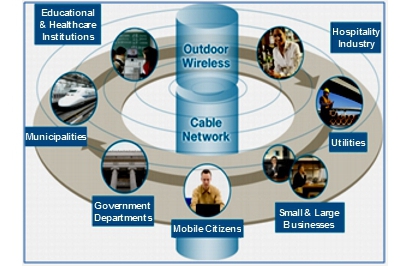

The CBI™ Business Model
Converged Broadband Infrastructure™ (CBI) injects symmetry to
classically vertical telco
business models changing assumptions about
ownership and access to infrastructure and delivering broadband
connectivity as a "fourth utility" to all potential users in a market.
 Globally, government driven national
programs are being put into place to connect their entire citizenry and economies to the World Wide Web.
Globally, government driven national
programs are being put into place to connect their entire citizenry and economies to the World Wide Web.
In the U.S., there is more reliance on the private sector. However, to entitle those currently unserved or underserved the U.S. government has embarked on an initiative to stimulate private and other public investment in those areas that are least likely to otherwise obtain broadband access.
The nature of the U.S. government driven broadband initiative opens up opportunities for business investment and attractive returns, but only with the proper business model in place.
The CBI™ business model is as necessary to the success
of the overall strategy as the bandwidth itself.
In the United States, there is a great reliance on the private sector to participate and help meet the anticipated $350 billion 8–10 year cost of establishing a national next generation true broadband network. CBI™ understands that investors need low risk, rapid payback, and secure, predictable returns on investment in order to divert so much from other capital markets and place it into next generation broadband. In order to attract private capital and to encourage public matching financing of infrastructure, the CBI™ business model is unlike any traditional telco and is in-synch with the most advanced broadband business thinking on the planet.
CBI™ will equip its clients and partners with articulated next gen broadband networks. These networks will have clear advantages over traditional telcos owing to its public ownership/private management approach to developing and operating "open source" infrastructure. They will also enjoy open access supporting multiple service providers. The CBI™ business model will offer capacity for a completely new range of voice, video and data products that can be offered by service providers. CBI™ will provide low-risk; early payback and high return opportunities for investor.
Key Elements in the CBI™ Business Model
Future Proof Design — Seamless fiber and wireless connectivity providing 1,000 Mbps broadband speed allowing even HD video over wireless connections that can be upgraded to meet increasing demands and future innovation in technology.
Open Access — multiple voice, video and data service providers will be carried over a single universally accessible infrastructure each with the capability of delivering enhanced services unavailable on their present proprietary or leased connections
Public Ownership — transfers debt and maintenance to a public authority and promotes economic development and increased efficiency and effectiveness of municipal and public safety services
Private Operating and Marketing — establishes service provider accounts and access to end users on the universal infrastructure. Charges fees per/user to service providers and receives fees for maintenance from the public authority from which are derived cash flows and return on investment
e-Citizen Public Access Mandate — The CBI™ Business Model takes full advantage of the mandate for free and reduced cost e-citizen access to essential municipal services; information and educational services; and enhanced benefits and security from broadband enabled intelligent transportation, public safety and first responder capacities.
Universal Access — Ubiquitous connectivity made available to every individual, commercial government and institutional end-user in the market. CBI™ sees universal access as the key element in its planned success in securing early adoption and pre-sales from voice, video and data service providers anxious to maintain and increase their market share.